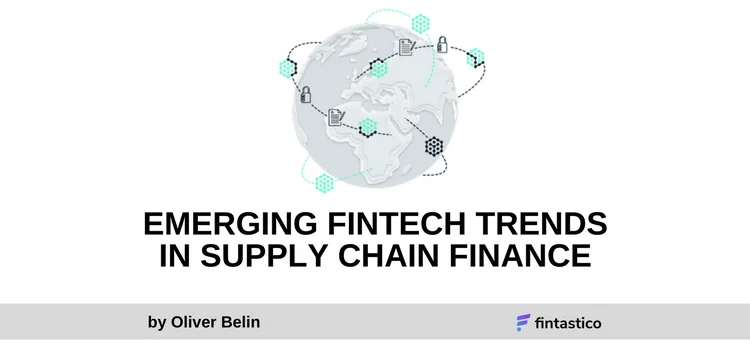- 22/01/2018

With the market experiencing increased interest in Supply Chain Finance, which encompasses solutions that help corporates buyers and their supplier to improve working, the industry is moving from an ongoing evolution to a revolution. A key part of this revolution comes from emerging fintech players in Supply Chain Finance, a market with a potential of over $2 trillion in financeable highly secure payables. While commercial banks still dominate a large part of this market, it is unquestionable that fintech solution providers are disrupting the industry with many financial institutions collaborating in order to stay competitive.
Initially, Supply Chain Finance solutions and dedicated technology platforms were introduced by the corporate buyers themselves such as the German retailer Metro Group and their in-house entity MIAG or the French retail giant, Carrefour with the subsidiary FINIFAC. However, the market and options have evolved since then with more and more large commercial banks rolling out their own Supply Chain Finance platforms. In the 21st century, fintech providers, initially just offering cloud based technology platforms without funding emerged and started to introduce dedicated services around Supply Chain Finacne including supplier onboarding, spend analysis, and electronic invoicing.
Currently, over 12% of all Supply Chain Finance programs in Europe are managed through fintech platforms, according to a recent research from PwC with examples such as Siemens, Volvo, Auchan or Sainsbury's. Parallel to the development, the questions from corporates looking to set up a Supply Chain Finance changed from "What is Supply Chain Finance" to "What are the benefits of using banks proprietary platform versus a fintech solution". There is no clear answer and in most cases is a trade-off between the following aspects:
- The risk of funding disruptions from a bank versus the risk of a fintech technology provider going out business
- The pricing for a fintech technology application versus less pricing competition by using a bank proprietary platform
- The cross-border capabilities of a bank versus a fintech provider for global Supply Chain Finance programs
- The relationship with a bank versus a bank-independent solution from a fintech provider
Many fintech providers typically have relationship with a network of banks and alternative financiers allowing the customers to select the best funding solutions for their program. However, the number of financial institutions can vary considerably between fintech providers. The same is the case with number of programs and suppliers using the platform.
Based of the growing interest in Supply Chain Finance with numerous facilities being implemented, companies face the challenge of having to use multiple, different platforms managed by banks and fintech providers. Today, it is not unusual for companies to be part of over a dozen of Supply Chain Finance programs, which one would think is good because of the risk and the concentration reduction. However, it requires a lot of time and efforts to join and manage these individual programs including onboarding, KYC checks, legal documentation, terms and conditions and differente technology platforms with various degree of automated integration capabilities.
These disconnected, inefficient setups place hard limits on business models, lead to a poor client experience, and restrict the ways, companies improve their working capital through Supply Chain Finance programs.
To solve these challenges and move to a new ecosystem, where banks and fintech providers are collaborating rather competing with the same underpinning technology behind the platforms since the 90s, some new model emerged in the market. These developments are focusing on automation, APIs and an open infrastructure, enabling more efficient Supply Chain Finance solutions through the creation fo trusted and permissioned interactions between financial institutions, corporate buyers, suppliers as well as, B2B networks and service providers.
One such example is TradeIX, a UK based company founded by Rob Barnes, who also started the Supply Chain Finance provider, PrimeRevenue more than a decade ago. Different, then current destination application models, where every provider competes against other fintech or banks proprietary platforms, TradeI creates a collaboration model rewiring all the participants in the trade finance ecosystem. Each bank, technology provider, including the corporates themselves can use their own Supply Chain Finance application (if already available), build their own through developer tools offered by TradeIX or can choose pre-built applications on the TradeIX platform. The underlying data is exchanged between all participants securely through dedicated APIs and leveraging distributed ledger technology. This allows to
- Reduces complexity and the number of intermediaries involved
- Reduces settlement, custodian and counterparty risk
- Manages credit risks better and more efficiently
Instead of using multiple destination applications, each participant can use their own customized solution based on their individual needs and leverage the long-standing relationships with their banks while allowing the collaboration with other financial institutions.
Traditionally, Supply Chain Finance was about funding and optimizing working capital. Today, the market evolved to new models focusing on collaboration, efficiency gains, better security and reduced costs in delivering such solutions. In the near future, we will see who will join this growing network of founders, credit insurers, B2B networks, technology and data providers and reap the benefits of this collaborative approach and who will be left behind with their destination application.



![What [the heck] is InsurTech? image](https://media.fintastico.com/images/network-782707_1280.2e16d0ba.fill-72x72.png)